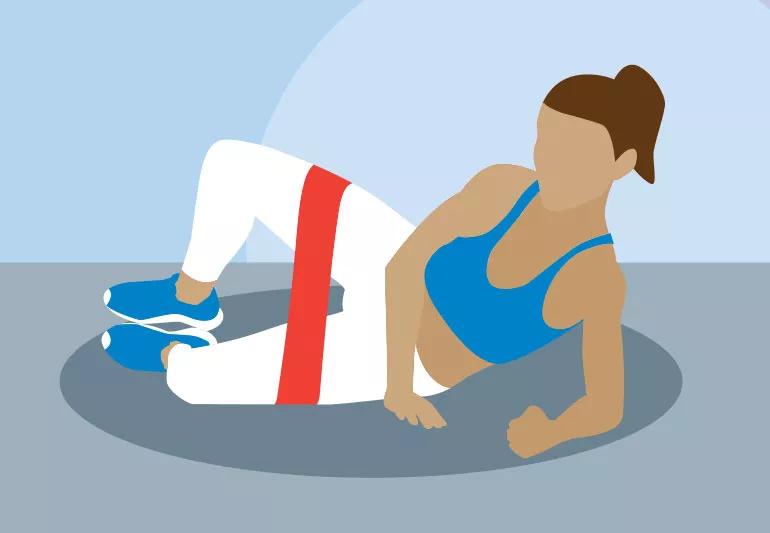Exercises to stretch your way to better strength

What look like large rubber bands can put a little extra snap into your strength-training routine.
Advertisement
Cleveland Clinic is a non-profit academic medical center. Advertising on our site helps support our mission. We do not endorse non-Cleveland Clinic products or services. Policy
Exercise resistance bands have become a mainstay of workout regimens for both muscled-up gym veterans and fitness training newcomers. The reason? They’re easy to use, extremely versatile and powerfully effective.
“No matter what your fitness level, resistance bands are a great piece of equipment to use,” says exercise physiologist Christopher Travers, MS.
But don’t let the simplicity of resistance bands fool you. There’s a correct way to use the bands in order to gain their muscle-building benefit. Let’s walk through some tips and exercises with Travers.
In resistance band training, you replace bulky exercise equipment with rubber resistance bands that you stretch. The force it takes to stretch the bands works your muscles just like using free weights or machines.
Absolutely. In fact, a 2019 study shows that training using resistance bands provides similar strength gains to using conventional gym equipment.
“Resistance bands might not look like much, but they can strengthen your muscles as effectively as more traditional weights,” says Travers. “In many ways, bands put more tension on your muscles and work them longer during movements.”
Resistance bands began as a way for nursing home residents to build strength. Eventually, they became much more mainstream as people discovered the perks of training with these giant rubber bands.
Advertisement
Advantages of resistance bands include:
Working with resistance bands doesn’t just build muscle. It can also help melt away fat.
A study published in 2022 shows that resistance band training lowers body fat in people who are overweight better than other forms of training, including free weights and bodyweight exercises. The review looked at 18 trials involving 669 participants.
Resistance bands range from simple, flat therapy bands to flat loop bands and elastic tubing with interchangeable handles that make them more user-friendly.
Choose a set of bands with varying resistances, or tension levels. Bands often are color-coded, with greater tension offered as the band colors get darker. (More tension is the equivalent of more weight, to put it in lifting terms.)
The more strength that’s required for an exercise, the higher the resistance you’ll need from the band. (As an example, you’ll need more tension for a chest press than a bicep curl, explains Travers.)
Also, consider the types of accessories that come with the bands, such as door attachments or ankle cuffs, and match them with the types of exercise you plan to do.
Other tips include:
Don’t add too much resistance for an exerciser or you won’t have a smooth range of motion. You’ll benefit more from using good form with lower resistance than by trying to up the tension level.
“With any type of exercise, you have to maintain proper form and posture, just like you would if you were using an exercise machine,” advises Travers. “And the reps and resistance may change based on the individual. Just take your muscles to fatigue to get the most out of a session.”
As you grow more comfortable with motions, it’s OK to challenge yourself by increasing the resistance on the resistance bands. Just make sure your form doesn’t break down when you go up a level.
Advertisement
A word of caution, too: Don’t overstretch bands to try to add resistance. That can cause a band to snap and lead to potential injuries.
Traverse recommends performing two sets of 15 repetitions of each of these exercises once a day on at least two days of the week:
Advertisement
This article was adapted from Cleveland Clinic Men’s Health Advisor.
Advertisement
Learn more about our editorial process.
Advertisement

The order of your workout matters when it comes to reaching fitness goals

A consistent exercise routine can bring you positive results from head to toe

Somatic yoga focuses on the sensation and experience of movement — not striking perfect poses

Being truly present in your body while you work out may reduce stress, heal trauma and more

Somatic Pilates is less form-focused and more experience-focused

Exercising and stretching your lower back, hamstrings, hips and quads can greatly improve your physical well-being

Perfecting the squat before trying a lunge can start you off on the right foot

Good form is essential for dumbbell rows, which work out your mid- and upper back

If you’re feeling short of breath, sleep can be tough — propping yourself up or sleeping on your side may help

If you fear the unknown or find yourself needing reassurance often, you may identify with this attachment style

If you’re looking to boost your gut health, it’s better to get fiber from whole foods